Connect With Us
Blog
Items filtered by date: May 2022
Preventative Foot Care for Diabetics
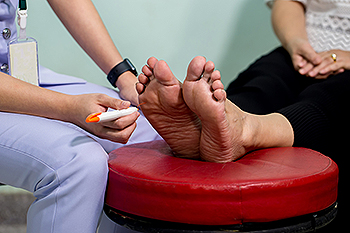
Anyone with diabetes is vulnerable to foot problems as a result of high blood sugar levels, which can damage the nerves in the legs and feet. The resulting numbness makes it more difficult to detect sores or cuts and to notice if shoes are too tight. It becomes harder to feel pain, temperature, and pressure, putting your feet in danger of infection. To avoid serious complications, such as foot ulcers, gangrene, or even amputation, a daily foot care plan is imperative for diabetics. First, check your feet daily for cuts, sores, or changes in color. Next, wash and carefully dry your feet before applying moisturizing cream to ward off dry or cracked skin. Avoid putting lotion between the toes. Protecting your feet is also essential. Wear shoes that fit properly, and avoid walking barefoot. Stop smoking, as it can further the damage to your blood vessels and can increase the risk of foot ulcers. Finally, anyone with diabetes is wise to have regular checkups with a podiatrist to monitor their foot health and stay ahead of problems.
Diabetic foot care is important in preventing foot ailments such as ulcers. If you are suffering from diabetes or have any other concerns about your feet, contact Arthur Segall, Jr., DPM from Segall Foot and Ankle. Our doctor can provide the care you need to keep you pain-free and on your feet.
Diabetic Foot Care
Diabetes affects millions of people every year. The condition can damage blood vessels in many parts of the body, especially the feet. Because of this, taking care of your feet is essential if you have diabetes, and having a podiatrist help monitor your foot health is highly recommended.
The Importance of Caring for Your Feet
- Routinely inspect your feet for bruises or sores.
- Wear socks that fit your feet comfortably.
- Wear comfortable shoes that provide adequate support.
Patients with diabetes should have their doctor monitor their blood levels, as blood sugar levels play such a huge role in diabetic care. Monitoring these levels on a regular basis is highly advised.
It is always best to inform your healthcare professional of any concerns you may have regarding your feet, especially for diabetic patients. Early treatment and routine foot examinations are keys to maintaining proper health, especially because severe complications can arise if proper treatment is not applied.
If you have any questions please feel free to contact our offices located in Plantation, and Ft. Lauderdale, FL . We offer the newest diagnostic and treatment technologies for all your foot and ankle needs.
Who Is Prone to Getting Sesamoiditis?
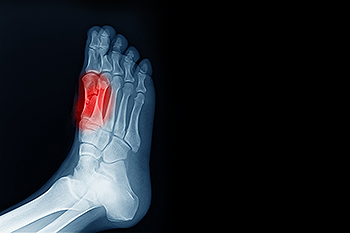
The two small bones in the ball of the foot under the joint of the big toe are referred to as the sesamoid bones. One is located on the outside of the foot, and the other is located closer to the center of the foot. Sesamoiditis occurs when the tissue that surrounds the sesamoid bones becomes inflamed and irritated. Sesamoiditis is considered to be a form of tendonitis, and can cause severe pain and discomfort. This generally happens from overuse and repeated pressure that is placed on the forefoot. The sesamoid bones absorb impact, and are responsible for helping the big toe move up and down during activity. Some of the symptoms that are associated with sesamoiditis can include foot pain that does not diminish, and the big toe may become stiff. People with increased chances of developing sesamoiditis include dancers, runners, and women who wear high heels. Effective treatment can begin with stopping the activity that caused this condition, resting the affected foot as often as possible, and possibly taping the big toe. If you have this ailment, it is strongly advised that you are under the care of a podiatrist who can help you with treatment options that are right for you.
Sesamoiditis is an unpleasant foot condition characterized by pain in the balls of the feet. If you think you’re struggling with sesamoiditis, contact Arthur Segall, Jr., DPM of Segall Foot and Ankle. Our doctor will treat your condition thoroughly and effectively.
Sesamoiditis
Sesamoiditis is a condition of the foot that affects the ball of the foot. It is more common in younger people than it is in older people. It can also occur with people who have begun a new exercise program, since their bodies are adjusting to the new physical regimen. Pain may also be caused by the inflammation of tendons surrounding the bones. It is important to seek treatment in its early stages because if you ignore the pain, this condition can lead to more serious problems such as severe irritation and bone fractures.
Causes of Sesamoiditis
- Sudden increase in activity
- Increase in physically strenuous movement without a proper warm up or build up
- Foot structure: those who have smaller, bonier feet or those with a high arch may be more susceptible
Treatment for sesamoiditis is non-invasive and simple. Doctors may recommend a strict rest period where the patient forgoes most physical activity. This will help give the patient time to heal their feet through limited activity. For serious cases, it is best to speak with your doctor to determine a treatment option that will help your specific needs.
If you have any questions please feel free to contact our offices located in Plantation, and Ft. Lauderdale, FL . We offer the newest diagnostic and treatment technologies for all your foot and ankle needs.
Let the Expert Treat Your Ingrown Toenails
What to Do About Stinky Feet
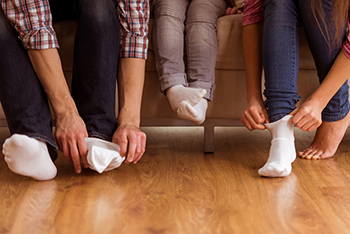
If your family members cringe when you remove your shoes, you may have a case of stinky feet. This unpleasant odor usually develops between the toes from the growth of micro-bacteria that thrive in damp, warm conditions. While stinky feet are unpleasant and can become chronic, there are some measures that can be taken to reduce the problem. The first and easiest suggestion is to develop a rigorous foot care regime to be practiced daily. Wash your feet with antibacterial soap, carefully washing between your toes. Dry the feet carefully and sprinkle them with corn-starch or absorbent foot powder. Wear wicking socks that draw the moisture away from the feet rather than trapping it, which can happen with 100% cotton socks. Change socks several times a day. Give your feet a chance to breathe by going barefoot for a while each day. Check that your shoes also give your toes room to breathe and consider alternating different pairs of shoes each day to let the sneakers dry out thoroughly. If the stinky feet problem persists or worsens, it is a good idea to visit a podiatrist who will have more advanced treatments available.
Everyday foot care is very important to prevent infection and other foot ailments. If you need your feet checked, contact Arthur Segall, Jr., DPM from Segall Foot and Ankle. Our doctor can provide the care you need to keep you pain-free and on your feet.
Everyday Foot Care
Often, people take care of their bodies, face and hair more so than they do for their feet. But the feet are a very important aspect of our bodies, and one that we should pay more attention to. Without our feet, we would not be able to perform most daily tasks.
It is best to check your feet regularly to make sure there are no new bruises or cuts that you may not have noticed before. For dry feet, moisturizer can easily be a remedy and can be applied as often as necessary to the affected areas. Wearing shoes that fit well can also help you maintain good foot health, as well as making it easier to walk and do daily activities without the stress or pain of ill-fitting shoes, high heels, or even flip flops. Wearing clean socks with closed shoes is important to ensure that sweat and bacteria do not accumulate within the shoe. Clean socks help to prevent Athlete’s foot, fungi problems, bad odors, and can absorb sweat.
If you have any questions please feel free to contact our offices located in Plantation, and Ft. Lauderdale, FL . We offer the newest diagnostic and treatment technologies for all your foot and ankle needs.
Foods and Exercises May Help Poor Circulation
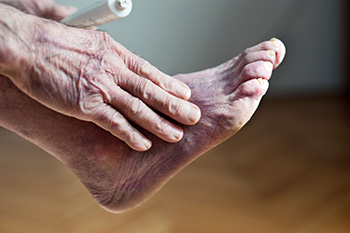
It is common for diabetic patients to have poor circulation in their feet. This is often the result of elevated blood sugar levels. Neuropathy can accompany this. It can be difficult to feel cuts and wounds on the feet, and the blood vessels can diminish in size. There are several methods to help poor circulation in the feet. These can consist of getting regular foot examinations, monitoring glucose levels, and wearing diabetic socks. Research has indicated that performing specific exercises may improve circulation in the feet. Some exercises can include cardiovascular activity such as walking or biking for five days per week. Additionally, it is important to keep blood pressure at a normal level and refrain from walking barefoot. Foods that are rich in vitamin C may help to naturally thin the blood, and it may help to incorporate foods that are rich in fiber into your daily food plan. If your feet are affected by poor circulation, it is strongly suggested that you confer with a podiatrist who can help you to manage this condition.
While poor circulation itself isn’t a condition; it is a symptom of another underlying health condition you may have. If you have any concerns with poor circulation in your feet contact Arthur Segall, Jr., DPM of Segall Foot and Ankle. Our doctor will treat your foot and ankle needs.
Poor Circulation in the Feet
Peripheral artery disease (PAD) can potentially lead to poor circulation in the lower extremities. PAD is a condition that causes the blood vessels and arteries to narrow. In a linked condition called atherosclerosis, the arteries stiffen up due to a buildup of plaque in the arteries and blood vessels. These two conditions can cause a decrease in the amount of blood that flows to your extremities, therefore resulting in pain.
Symptoms
Some of the most common symptoms of poor circulation are:
- Numbness
- Tingling
- Throbbing or stinging pain in limbs
- Pain
- Muscle Cramps
Treatment for poor circulation often depends on the underlying condition that causes it. Methods for treatment may include insulin for diabetes, special exercise programs, surgery for varicose veins, or compression socks for swollen legs.
As always, see a podiatrist as he or she will assist in finding a regimen that suits you. A podiatrist can also prescribe you any needed medication.
If you have any questions, please feel free to contact our offices located in Plantation, and Ft. Lauderdale, FL . We offer the newest diagnostic and treatment technologies for all your foot care needs.
Big Toe Arthritis Relief
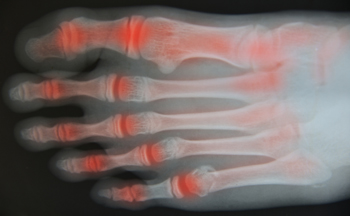
Arthritis in the first metatarsal phalangeal (MTP) or big toe joint is common, particularly as one begins to age. We use our feet to get us through life and normal walking, other movements, and wearing high heeled or improperly fitting shoes can stress the main joint of the big toe. Osteoarthritis or Hallux Rigidus is the most common arthritic condition affecting this joint and it can be quite painful and limit movement. The big toe may also become stiff and swollen. The best treatment for this condition is a fusion of the joint. The procedure fuses or welds together the two bones that make up the aching joint. It does not make the toe less stiff or restore motion, but it relieves the pain. An alternative procedure is a joint replacement of the big toe, but it is not ideal because the use of metal and plastic has not been successful in this type of joint replacement. It is not predictable in relieving pain, and repeated force on the joint with each step makes it less long-lasting than bigger joints, like the knee and hip. Options for treatment of a failed replacement are limited and may be replaced with bone grafting and joint fusion. If you suffer from pain in the joints of the big toe, consult with a podiatrist for the best treatment plan for you.
In certain cases, in which the patient suffers from extreme pain or damage in a joint, joint replacement surgery may be deemed useful. If you have constant pain in a foot joint, consult with Arthur Segall, Jr., DPM from Segall Foot and Ankle. Our doctor will assess your condition and provide you with quality foot and ankle treatment.
What Is Joint Replacement Surgery?
Over time, joints wear down; this can be exacerbated by diseases and conditions. Joint replacement surgery, also known as arthroplasty, is when a damaged joint is surgically removed and replaced with a prosthesis. Prostheses, which can be made of ceramic, plastic, or metal, act as joints in lieu of an actual joint. One of the most prevalent causes for joint replacement is arthritis.
Arthritis in the Foot
Arthritis can occur in any joint in the body, including in the feet. Common types of arthritis in the foot are osteoarthritis, rheumatoid arthritis, and gout. The big toe is usually where arthritis occurs in the foot; this is known as hallux rigidus.
Joint Replacement Surgery in the Foot
The most common form of joint replacement in the foot is a first metatarsophalangeal (MTP) joint placement. MTP joint replacement surgery is designed to treat hallux rigidus. Surgery is not intensive, and recovery occurs within one to two months after the procedure has been done. Overall, joint replacement surgery is a safe and effective way to treat pain in the joint of the foot.
If you have any questions, please feel free to contact our offices located in Plantation, and Ft. Lauderdale, FL . We offer the newest diagnostic and treatment technologies for all your foot care needs.

